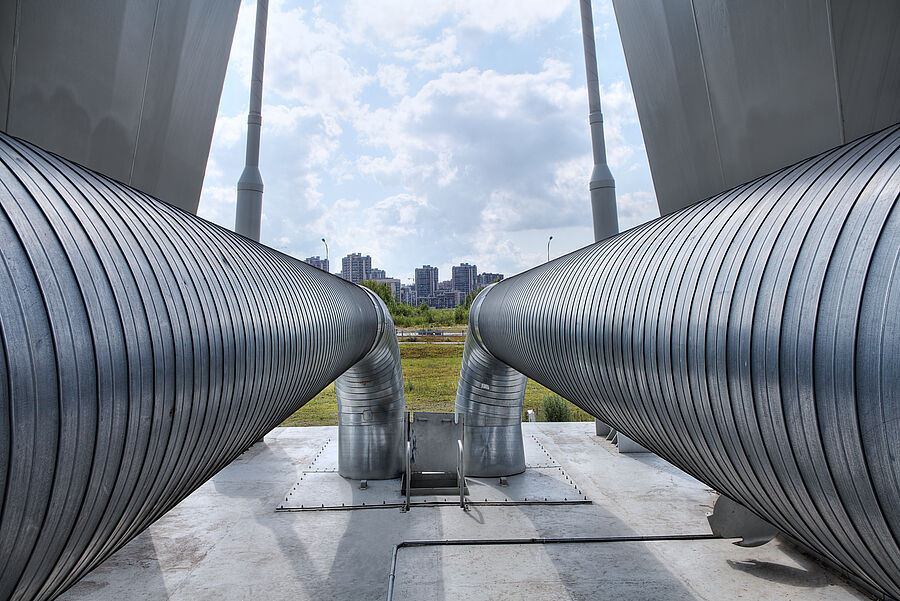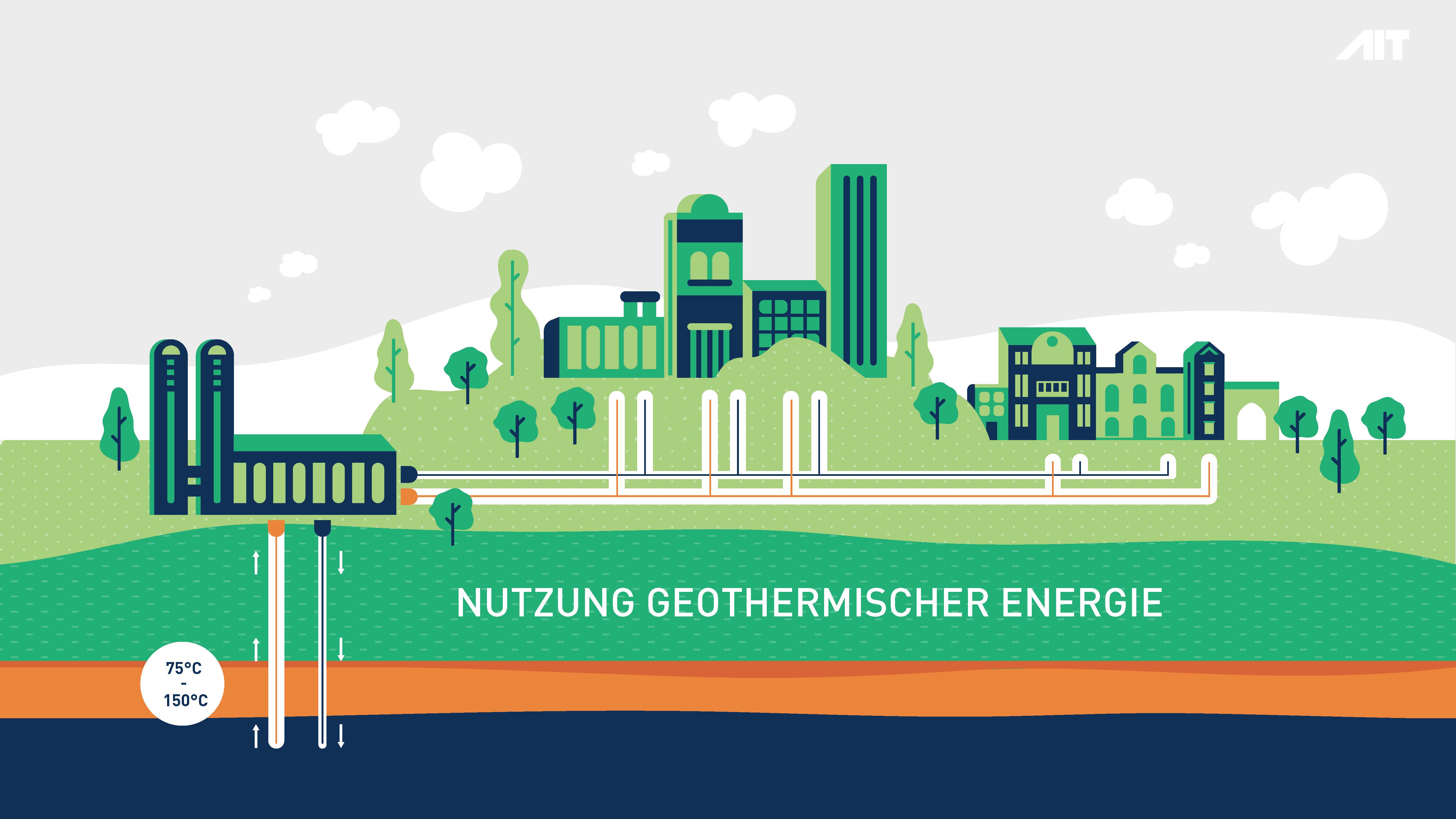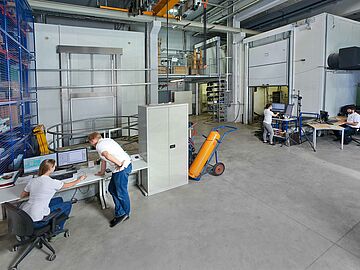Utilising geothermal energy for a sustainable energy future
What is geothermal energy?
Geothermal energy utilises the thermal energy stored in the earth's crust, which is generated by two main processes: the residual heat from the formation of the earth and the ongoing production of heat through radioactive decay.
The utilisation of geothermal energy is becoming increasingly important as it offers a sustainable and environmentally friendly alternative to fossil fuels. It also plays a key role in global change and the heat transition. Geothermal energy is a renewable energy system that is used in the areas of heating and cooling supply, electricity production and heat storage and also contributes to carbon dioxide (CO2) reduction.
How does geothermal energy work?
Geothermal energy is based on utilising the natural temperature difference between the earth's surface and the deeper layers of the earth. The earth has a hot core surrounded by liquid and solid rock. This core continuously generates heat, which flows outwards through the earth's crust.
Geothermal technology utilises this heat flow by using geothermal systems to extract heat from the earth. This is done, for example, by using boreholes to gain access to hot rock or water layers that lie deep below the earth's surface. Depending on the depth and temperature, different technologies can be used to generate heat or electricity.
- Geothermal gradient: The geothermal gradient, which describes the increase in temperature with soil depth, prevails underground. It can be assumed that the deep temperature of the earth in Central Europe rises by approx. 3 °C every 100 metres. This gradient forms the basis for the utilisation of geothermal energy. Geothermal heat flow: The temperature gradient between the earth's surface and the earth's interior transports heat from the depths to the surface.
- Heat transfer mechanisms: Systems such as geothermal probes or geothermal power stations use water or other fluids to transport the heat to the surface.
Nutzung von Geothermie
Types and applications
Classification by depth
Geothermal systems can be categorised in different ways. A common categorisation in Austria distinguishes between near-surface (up to 300 m) and deep geothermal energy (greater than 300 m) according to the depth of the boreholes drilled.
Near-surface geothermal energy
Near-surface geothermal energy utilises the constant temperature in the upper layers of the earth. It is mainly used for heating and cooling buildings. Systems such as geothermal probes or geothermal collectors as well as well systems with groundwater heat pumps play a decisive role here.
In both geothermal probes and collectors, a fluid (usually a water/glycol mixture) is pumped through a closed pipe system in the subsurface, thus transferring the heat or cooling energy of the subsurface to the medium. Back on the surface, the previously absorbed energy is extracted from the medium with the help of heat pumps and used to heat or cool buildings.
Deep geothermal energy
Deep geothermal energy utilises sources that lie several hundred to a thousand metres below the earth's surface. Deep geothermal systems can basically be divided into two geothermal energy utilisation systems. The first is hydrothermal geothermal energy, which draws heat from underground thermal sources, and the second is petrothermal geothermal energy, which is subdivided into hot dry rock systems and closed deep heat exchanger systems (geothermal probes). The main differences between the two systems therefore lie in the naturally occurring hydrological (thermal water from aquifers) and geological (heat in the rock) conditions. The temperatures here are considerably higher, which also enables the generation and utilisation of electricity. Deep geothermal power plants often utilise hot water or steam, which is used directly to generate electricity.
Due to the large volume and thermal inertia of the earth, geothermal energy is also ideally suited for the medium and long-term storage of heat. Using today's methods, geothermal heat storage covers the temperature range from below 10°C (cold) to approx. 90°C. On the one hand, waste heat from industrial processes or excess heat from district heating can be stored over longer periods of time.
Temperature-based categories
A common classification according to the type of use in Central Europe distinguishes between
- less than 30°C: Low temperature - heating with heat pump and direct geocooling
- 90°C medium temperature - direct heating, balneology
- more than 90°C high temperature - district heating and electrical energy
Low-temperature geothermal energy
Low-temperature systems usually operate at temperatures below 30°C . They are ideal for applications such as heating residential buildings, greenhouses or swimming pools with the aid of heat pumps. These systems are cost-effective and easy to install, making them ideal for local energy projects.
Medium-temperature geothermal energy
Temperatures between 30 and approx. 90 °C are often used for low-temperature industrial processes or to generate electricity in special power stations. This type of geothermal energy is less common, but has great potential, especially in industrial applications.
High-temperature geothermal energy
At temperatures of > 90 °C, the available geothermal energy can also be used for binary power generation processes or electricity. Such systems are particularly common in regions with active geological activity.
Advantages of geothermal energy
Sustainability and renewable properties
Geothermal energy has a special status compared to other sustainable energy sources because it is available almost everywhere and can be recovered. In addition, geothermal energy has a permanent supply and is always accessible for the demand for thermal energy and electricity. This makes it an environmentally friendly source of energy that takes up very little space above ground. The use of geothermal energy has the advantage of being free from geopolitical influences and also contributes to the conscious use of this resource.
Availability and reliability
Compared to other forms of renewable energy, geothermal energy is unfortunately still a niche technology in Europe, although there are numerous advantages in favour of greater expansion! The biggest unique selling point of geothermal energy compared to other forms of energy such as wind, solar energy or hydropower is its constant availability. Regardless of seasonal, climatic fluctuations or the time of day, geothermal energy supplies energy all year round.
Environmental benefits
Geothermal energy has an extremely low carbon footprint, especially compared to fossil fuels. Most geothermal systems require little land area and have minimal impact on the local environment. It is also a base-load capable form of energy and one of the cleanest energy sources that supports decarbonisation as a reliable emission-free energy supplier.
Challenges in the utilisation of geothermal energy
Costs for exploration and development
One of the biggest obstacles to utilising geothermal energy is the high initial investment. The exploration of suitable sites requires extensive geological investigations, including drilling and seismic testing, which are extremely cost-intensive.
The development of geothermal plants, especially for deep geothermal energy, can cost several million euros before energy production can even begin. These high costs often deter potential investors, although the operating costs after commissioning usually prove to be very low.
Technological challenges
Although the technology for utilising geothermal energy is advanced, it is still associated with hurdles. For example, tapping deep geothermal resources requires highly specialised drilling techniques and materials that can withstand extreme temperatures and pressures.
The future of geothermal energy
Innovation and research
The future of geothermal energy looks promising, as there is continuous investment in research and development. Advances in drilling technology, such as the development of plasma or laser techniques, could make it much easier to tap into deep resources and reduce costs.
In addition, new materials, material coatings and heat exchange systems enable more efficient utilisation of medium and low temperatures, which expands the areas of application for geothermal energy.
Integration with other renewable energies
Another trend is the combination of geothermal energy with other renewable energy sources such as solar and wind power. Such hybrid systems can compensate for fluctuations and ensure a stable energy supply.
In urban areas in particular, geothermal energy is increasingly being integrated into district heating networks as a reliable heat source. This development emphasises the potential of geothermal energy as a key technology for a sustainable energy future.
Frequently asked questions
- What makes geothermal energy renewable?
Geothermal energy utilises the inexhaustible heat from the earth's interior, which is continuously renewed by natural processes such as radioactive decay and geothermal gradients. - Can geothermal energy be used everywhere?
No, the efficiency of geothermal energy depends heavily on the geological location. Regions with high geothermal activity, such as volcanic areas, are particularly suitable. - How does geothermal energy compare to solar and wind energy?
Geothermal energy is more reliable as it is independent of weather conditions, whereas solar and wind energy depend on the sun and wind. - What is the global potential of geothermal energy?
It is estimated that geothermal energy could cover around 10-20% of the world's total energy needs if its full potential is realised.





